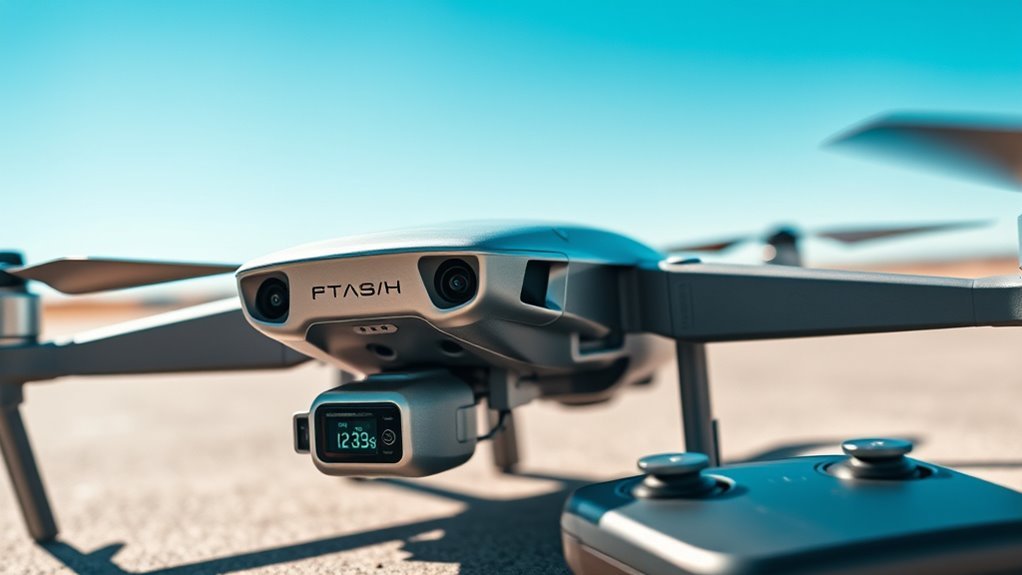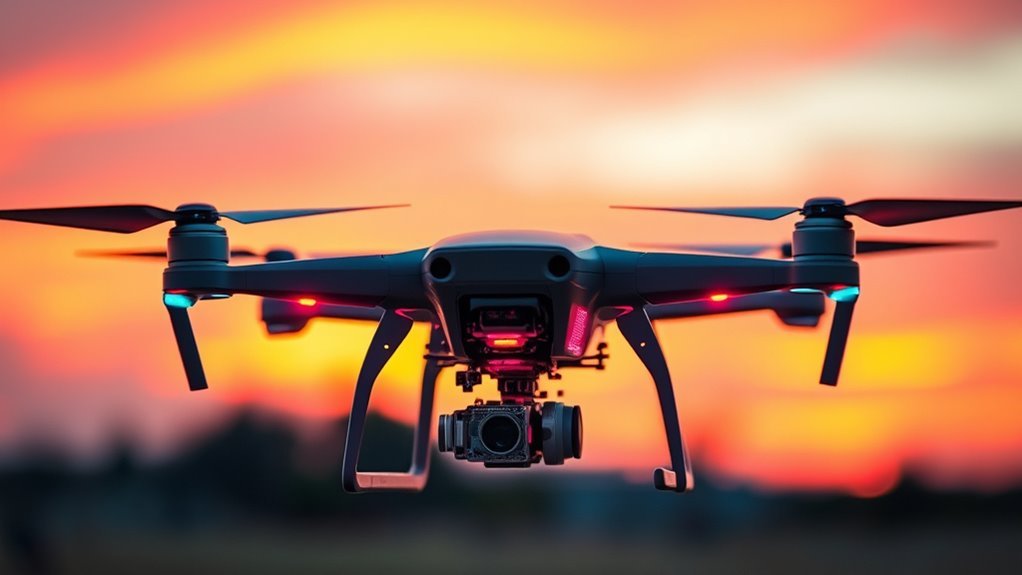Drone-controlled systems operate on a blend of advanced technologies. Lightweight materials, sophisticated propulsion systems, and high-resolution sensors provide stability and efficiency. Robust communication systems guarantee real-time data transfer, while advanced GPS navigation allows for precise positioning. Integration of artificial intelligence enables autonomous decision-making and improved obstacle avoidance. Together, these elements enhance performance and safety. Curious to uncover more insights about the advancements shaping drone technology?
Overview of Drone Technology

Drones, or unmanned aerial vehicles (UAVs), have revolutionized various industries by integrating advanced technology for flight control and guidance. These systems are increasingly employed in diverse applications, from agriculture to surveillance, enhancing efficiency and precision. Furthermore, the integration of advanced AI into drone operations can significantly streamline processes, similar to how it enhances security automation in other fields. However, as you explore drone applications, it’s vital to understand the regulatory challenges that accompany their use. Governments worldwide are working to establish frameworks that guarantee safety while promoting innovation. These regulations often focus on airspace management, privacy concerns, and operational limits, which can affect how you utilize drones. Staying informed about these challenges is essential for maximizing the potential of UAV technology while staying compliant. As drone technology evolves, maneuvering through these regulations will play a pivotal role in shaping the future of aerial operations. Additionally, understanding signal attenuation is crucial for optimizing drone performance in various environments.
Key Components of Drone Systems

Understanding the intricacies of drone technology requires a closer look at the key components that make up these systems. Central to drone functionality are the materials used in their construction. Lightweight, durable materials like carbon fiber and plastic not only enhance maneuverability but also contribute to flight stability. The propulsion system, comprising motors and propellers, plays a critical role in achieving ideal lift and control. Additionally, the flight controller, which processes data from the onboard sensors, guarantees precise navigation and stability during flight. Battery technology is another essential aspect, providing the necessary power while balancing weight. Each component works in harmony, enabling you to experience the freedom and versatility that drones offer in various applications. The advanced battery optimization techniques ensure that drones can fly longer and more efficiently, enhancing their overall performance. Moreover, the use of superior battery efficiency in high-end models, like the EXO Blackhawk 3, allows for significantly extended flight durations.
Advanced Sensors in Drones

In the domain of drone technology, advanced sensors play an essential role in enhancing operational capabilities. You’ll encounter various types of sensors, each serving specific functions, and understanding their integration techniques is important for optimizing performance. The impact of these sensors on drone efficiency and effectiveness cannot be overstated, influencing everything from navigation to data collection. Moreover, innovations in camera technology enable drones to capture high-resolution images for improved data analysis and situational awareness. High-resolution sensors provide enhanced threat detection, allowing drones to identify potential risks with remarkable clarity and speed.
Types of Advanced Sensors
As the demand for aerial data collection grows, the integration of advanced sensors into drone technology has become essential for enhancing operational capabilities. Two prominent types of sensors include thermal imaging and LiDAR scanning. Thermal imaging sensors detect heat signatures, allowing you to identify temperature variations, which is important for search and rescue missions, building inspections, and wildlife monitoring. On the other hand, LiDAR scanning employs laser pulses to create detailed, three-dimensional maps of terrain and structures. This technology is particularly valuable in forestry, agriculture, and urban planning, providing high-resolution data that traditional methods can’t match. By leveraging these advanced sensors, you can achieve greater accuracy and efficiency in various applications, ultimately empowering you to make informed decisions with freedom in data analysis.
Sensor Integration Techniques
While integrating advanced sensors into drone systems, it’s essential to guarantee seamless communication between the sensors and the drone’s onboard processing units. Achieving this involves addressing several integration challenges, particularly in sensor calibration. You need to evaluate:
- Data Fusion: Combining data from multiple sensors for accurate environmental perception.
- Synchronization: Ensuring time alignment between sensor inputs to maintain data integrity.
- Compatibility: Selecting sensors that can effectively interface with existing drone architectures.
Impact on Drone Performance
Advanced sensors greatly influence drone performance, enhancing capabilities across various applications. By integrating advanced imaging, LiDAR, and environmental sensors, you can considerably boost flight efficiency and decision-making processes. These sensors enable real-time data collection, allowing for adaptive flight paths that respond to changing conditions, ultimately improving drone durability. Enhanced durability is critical, as robust sensors withstand harsher conditions, extending operational life. Furthermore, the data gathered not only optimizes energy consumption but also reduces wear on components, contributing to longer service intervals. In mission-critical operations, these advancements translate to reliable performance, ensuring your drone can execute tasks with precision and resilience. Embracing these technologies empowers you to explore new horizons in drone applications.
Communication Systems for Drones
When operating a drone, the effectiveness of communication systems is vital for both remote control and data transmission. You’ll need to understand the various remote control technologies, such as RF and Wi-Fi, that enable real-time interaction with the drone. Additionally, exploring data transmission methods will reveal how drones relay essential information back to the operator efficiently. Moreover, real-time coordination algorithms play a crucial role in ensuring seamless interaction among multiple drone units. The integration of advanced communication systems enhances the ability of drones to share critical data and maintain operational effectiveness across varying environments.
Remote Control Technologies
As drone technology evolves, the effectiveness of remote control systems has become essential for ensuring reliable communication between operators and their aerial vehicles. You rely on advanced control interfaces to maintain command and achieve your objectives. Key elements include:
- Radio Frequency (RF) systems – These allow for long-range communication, providing the freedom to maneuver without constraints.
- Wi-Fi connections – Offering high-speed data transfer, enabling real-time adjustments and remote access to the drone’s systems.
- Cellular networks – Expanding communication capabilities, especially for operations beyond line-of-sight, ensuring you remain in control from virtually anywhere.
These technologies empower you to navigate challenges, ensuring your drone operates efficiently while granting the autonomy and flexibility you desire.
Data Transmission Methods
Reliable communication systems play a pivotal role not just in remote control but also in data transmission methods that underpin drone operations. You’ll often rely on robust data links to guarantee seamless interaction between your drone and its controller. These connections enable real-time data transfer, critical for tasks like surveillance or mapping. Wireless protocols, such as Wi-Fi, Zigbee, and LTE, provide the necessary bandwidth and reliability for various applications, allowing you to transmit high-definition video and telemetry data efficiently. Understanding these technologies empowers you to select the most suitable system for your specific needs, enhancing both the performance and autonomy of your drone. Ultimately, effective data transmission methods are crucial for maximizing your operational freedom and guaranteeing mission success.
Role of GPS and Navigation Systems
Although drones can operate autonomously, their effectiveness heavily relies on advanced GPS and navigation systems. High GPS accuracy guarantees precise positioning, enabling your drone to follow a designated path. To achieve ideal performance, consider these key elements:
Drones thrive on advanced GPS and navigation systems, ensuring precise positioning and reliable autonomous operation.
- GPS Accuracy: Essential for reliable location data, it minimizes deviations during flight. The quality of GPS signals can be affected by urban canyons that create localized coverage gaps.
- Navigation Algorithms: These algorithms process GPS signals, allowing your drone to calculate the best route dynamically.
- Real-Time Updates: Continuous signal adjustments empower your drone to react to obstacles, enhancing safety and efficiency. Additionally, advancements in long-range communication systems have greatly improved the reliability of drone navigation over extended distances.
With robust GPS and navigation systems, your drone can navigate complex environments, providing you with unparalleled freedom to explore and accomplish tasks with confidence.
Artificial Intelligence in Drone Operations
With advanced GPS and navigation systems establishing a solid foundation for drone operations, the integration of artificial intelligence (AI) takes functionality to the next level. AI empowers drones through autonomous navigation, allowing them to adapt to dynamic environments and make real-time decisions. By leveraging machine learning algorithms, drones continuously improve their performance by analyzing past flight data and outcomes. This self-learning capability enhances obstacle avoidance, path optimization, and mission execution, giving you greater operational efficiency and safety. Additionally, AI-driven systems can process complex scenarios, enabling drones to operate in challenging conditions without human intervention. Ultimately, the fusion of AI with drone technology not only elevates their capabilities but also aligns with the growing demand for freedom and autonomy in aerial operations. Furthermore, AI enhances flight safety through real-time obstacle detection, ensuring drones can navigate safely in various environments. The incorporation of fault-tolerant designs further reduces operational risks, enhancing the reliability of autonomous drone systems.
Data Processing and Analysis in Drones
As drones capture vast amounts of data during their operations, efficient data processing and analysis become critical for extracting actionable insights. You can harness advanced technologies to optimize data collection and image processing, enabling improved decision-making. Key aspects of this process include:
- Data Filtering: Eliminating irrelevant information guarantees only pertinent data is analyzed.
- Image Enhancement: Utilizing algorithms enhances image quality, revealing hidden details in aerial footage.
- Analytics Integration: Merging data sets with analytical tools helps you visualize patterns and trends. Additionally, real-time data processing allows for immediate insights, facilitating on-the-spot decision-making.
Future Trends in Drone Technology
The advancements in data processing and analysis set the stage for emerging trends in drone technology that promise to revolutionize various industries. You’re likely to see significant improvements in autonomous navigation, allowing drones to traverse complex environments without human intervention. This capability enhances operational efficiency and safety, essential for applications ranging from delivery services to agricultural monitoring. Additionally, drone swarming technology is on the rise, enabling multiple drones to collaborate seamlessly towards a common objective. This trend could lead to breakthroughs in search and rescue operations or environmental monitoring, where coordinated efforts yield superior results. As these technologies evolve, they’ll provide you with unprecedented freedom and flexibility in deploying drone solutions across diverse sectors. Furthermore, advanced stabilization systems in drones will play a crucial role in ensuring reliable performance in various conditions. The integration of high-resolution imaging used in agriculture can also enhance drone capabilities by providing critical data for more precise operations.
Frequently Asked Questions
How Do Weather Conditions Affect Drone Performance?
Did you know that 60% of drone failures occur due to adverse weather? Wind resistance, temperature effects, humidity impact, and precipitation challenges all greatly affect your drone’s performance, limiting its effectiveness and reliability in various conditions.
What Are the Legal Regulations for Drone Usage?
You need to understand drone regulations to guarantee legal compliance. These rules vary by region, impacting flight altitude, no-fly zones, and usage purposes. Ignoring them can lead to significant penalties and restrictions on your freedom to operate.
Can Drones Be Hacked or Compromised?
You should know that drones can indeed be hacked or compromised. With evolving hacking techniques targeting drone security, vulnerabilities exist that could allow unauthorized access, potentially jeopardizing personal privacy and safety. Stay informed and proactive.
What Is the Lifespan of a Typical Drone?
A typical drone’s lifespan varies, influenced by drone maintenance tips and external factors like usage and environment. Regular care can extend its life considerably, so you should always prioritize proper maintenance for ideal performance.
How Do Drones Handle Battery Management and Charging?
You’ll find drones utilize advanced battery optimization techniques, ensuring efficient energy use. Coupled with robust charging infrastructure, they manage power effectively, extending flight time and enhancing operational freedom, essential for various applications and user experiences.

